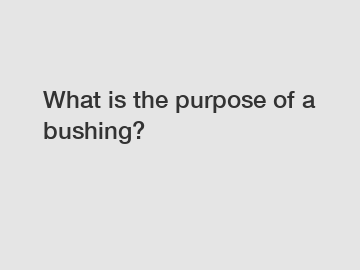What is the purpose of a bushing?
What is the purpose of a bushing?
When it comes to mechanical systems, there are numerous components and parts that work together to ensure smooth functioning. One such element that often goes unnoticed is the bushing. A bushing is a cylindrical device that is placed in a hole to act as a bearing or support. It plays a crucial role in reducing friction and wear between moving parts, as well as providing stability to the overall system. In this article, we will delve deeper into the purpose of a bushing and understand its significance in various applications.
Reducing Friction and Wear.

One of the primary functions of a bushing is to minimize friction and wear between moving parts. By providing a smooth surface for the rotational or linear motion of a shaft or pin, the bushing acts as a barrier between different elements. This friction reduction is essential in prolonging the lifespan of the system and preventing excessive wear and tear.
Support and Stability.
Another vital purpose of a bushing is to provide support and stability in mechanical systems. When a shaft or pin needs to be accurately positioned or guided, a bushing can be used to ensure precise alignment. It helps eliminate any unwanted or excessive movement of the components and maintains the integrity of the system. Additionally, a bushing can absorb shock and vibration, thereby enhancing the stability of the machinery.
Vibration Damping.
In certain applications, excessive vibrations can be detrimental to the performance and reliability of the system. Here, a bushing can play a significant role in damping vibrations. By absorbing and dissipating energy, the bushing reduces the intensity of vibrations transmitted between different parts, leading to a smoother operation and improved functionality.
Insulation and Electrical Protection.
Bushing materials can also be selected to provide insulation and electrical protection. In electrical systems, for example, bushings made from insulating materials are used to protect conductive parts from damage or short-circuits. These insulating bushings not only prevent the flow of electricity but also provide mechanical support in the system.
Types of Bushings.
Various types of bushings are utilized in different applications, depending on specific requirements. Some common types include:
1. Sleeve Bushings: These are the simplest type of bushings, consisting of a plain cylindrical tube that provides support and reduces friction.
2. Flanged Bushings: These are similar to sleeve bushings but have a flange at one end. The flange helps prevent lateral movement and provides additional stability.
3. Tapered Bushings: As the name suggests, these bushings have a tapered shape and are often used in applications where shafts need to be mounted on different-sized hubs or pulleys.
4. Split Bushings: Split bushings allow for easy installation and removal without the need to disassemble the entire system. These are particularly useful in applications where regular maintenance is required.
In conclusion, the purpose of a bushing is multifaceted, ranging from reducing friction and wear, providing support and stability, damping vibrations, to offering insulation and electrical protection. Its significance in mechanical systems cannot be overlooked. The selection of the right type of bushing and its appropriate installation can greatly enhance the performance and longevity of the overall system.
If you have any further questions or need assistance with bushings or any other mechanical components, please do not hesitate to contact us. We are here to help!
Contact us to discuss your requirements of Loaf Neodymium Magnet, Exact Positioning Shuttering Magnet, Internal Threaded Pot Magnet Of Ndfeb. Our experienced sales team can help you identify the options that best suit your needs.


